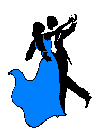 |
ROUND DANCING — CHOREOGRAPHED BALLROOMEDUCATIONAL ARTICLESMAJOR SECTIONS: Figures | Articles | Links | Alph. Index | Search | Home |
|
|
On Body Mechanics IIby Roy & Phyllis Stier Continuing on body mechanics where we left off last time. We like to think of the ballroom CBM (contrary body movement) as "shaping," or turning the upper body in preparation for turns. To keep the sometimes perplexing terms separate, the CBMP (contrary body movement position) is strictly a foot alignment consideration, which we will refer to later. For shaping, we must first lower onto the supporting foot (right foot for left turns and left foot for right turns) so that there is a firm foundation for the figure to follow. Most men will make a slight rise to "gather" his partner to telegraph the movement into the next sequence. The degree of shaping is dictated by the figure; i.e., moderate for a left turn, more for a Telemark, and considerable for a Double Reverse Spin. Since most round dancers learn the American waltz before they tackle the International, we need to point out some significant differences. American waltz has a faster rhythm and uses more open work with a continuous flow, whereas International uses more picture figures and the pause between movements more often. American waltz has a down, up, up sequence of movement as contrasted to the International down, down, up feeling, therefore, the American variety is more like the body rise we use in fox trot. Many of our classics have a mixture of both where the International figures are quite often disguised.The matter of sway is largely ignored in most round dancing, sometimes treated as practically heretic because it is considered strictly a ballroom technique. It should be a definite part of the performance of all those who are at the level of Phase IV or above as we now categorize abilities. The sway in the direction of the turns in waltz and fox trot (steps 2 & 3) greatly facilitate the positioning for the other. The swing effect of step 2 brought about by sway, for instance. If we maintain the sway on step 3 before bringing the body back to normal position it positively enhances the control which is so often lacking. Lifting the right side for left turns and the left side for right turns is something we often hear but not always practice. While on sway, we should point out that on certain rotary figures, such as the Double Reverse Spin, Double Natural, Pivots, Top Spin, and a few others, we do not sway but depend upon body momentum to complete the figure. In occasions like performing the Spin Turn and Impetus Turn, the sway is not as evident because of the amount of rotary action involved, however, this is also true of most subtle turning actions, such as we find in the Whisk and the Weave. On the other hand, we develop a great deal of sway in figures that have no turns or very little; example: the Feather Step in fox trot (none) or in the middle of the Hover Cross (slight turn to the right). Stay turned, we'll continue on body mechanics.
This column comes from a series published in Cue Sheet Magazine between 1987 and 1992, and is reprinted with permission. The full series is collected in an 86-pg booklet, available for $30.00 plus postage. E-mail Fran Kropf at cutecuer@cox.net. This article was published in the Dixie Round Dance Council (DRDC) Newsletter, September 2009.
|
 |
|
|
Page last revised